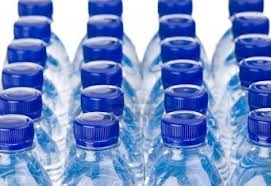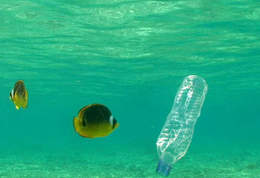 I remember the first time I saw a bottle of water for sale, thinking it was the most ridiculous thing I'd ever encountered. Who the heck would actually PAY to drink water when they could get it for free at home? That's just crazy! I drank out of the faucet every single day, or the garden hose in a pinch, and there was obviously nothing wrong with me (other than mentally). But there they were, plastic bottles of water lined up in a cooler next to the Fantas and Tabs, happily purchased by the same screwy people who were walking around yelling into those new huge Walkie Talkie things called "cellphones." It was sometime in the 1980s, in the midst of a generation that was itself defined by ridiculousness -- fads like the Rubik's Cube, specialty Nike running shoes for a whopping $50, and Atari's Miss Pacman, an introduction to the new religion of consumerism for its own sake.
I remember the first time I saw a bottle of water for sale, thinking it was the most ridiculous thing I'd ever encountered. Who the heck would actually PAY to drink water when they could get it for free at home? That's just crazy! I drank out of the faucet every single day, or the garden hose in a pinch, and there was obviously nothing wrong with me (other than mentally). But there they were, plastic bottles of water lined up in a cooler next to the Fantas and Tabs, happily purchased by the same screwy people who were walking around yelling into those new huge Walkie Talkie things called "cellphones." It was sometime in the 1980s, in the midst of a generation that was itself defined by ridiculousness -- fads like the Rubik's Cube, specialty Nike running shoes for a whopping $50, and Atari's Miss Pacman, an introduction to the new religion of consumerism for its own sake.
Back then, even the most optimistic capitalist couldn't have guessed where the water bottle industry was heading. Thirty years later it's not just a luxury item for those driving Porsche 911s with their salmon-colored collars up, but a stalwart of regular American life. Yes, me too -- I became one of those screwy people who bought bottled water by the case and yapped into his "cellphone" non -top (sometimes even when another person was on the line.)
But the damage from the bottled water industry isn't just to our intelligence and our wallets; it's also to the world we live in. Our environment is being impacted, not just the image of a nice sunny far-off meadow that word conjures but the actual surroundings that we depend on to sustain our lives. Our human fish tank is getting terrifically cloudy because of the plastic water bottles we buy and discard so thoughtlessly.
How big is the bottled water industry?
There are 50 billion water bottles consumed every year, about 30 billion of them in the US (which means we consume roughly 60 percent of the world's water bottles, even though we're about 4.5 percent of the world population).
There are 1,500 water bottles consumed per SECOND in the U.S.
2011 was a high point for bottle water sales, where 9.1 billion gallons were sold, or 29.1 gallons per person per year, the highest in sales and volume in history.
What does it take to manufacture the water bottles?
It takes three times the volume of water to manufacture one bottle of water than it does to fill it, and because of the chemical production of plastics that water is mostly unusable.
We use 17 million barrels of oil each year just to produce all of those water bottles.
To put it in perspective, that's enough oil to keep a million cars fueled for a whole year! (Or your Hummer to Ikea and back.)
The Earth Policy Institute factors the energy used to pump, process, transport and refrigerate our bottled water as over 50 million barrels of oil every year. That's an insane amount of resources for something that is a completely unneeded.
Another way to think of it: when you pick up a water bottle at the supermarket, hold it up and imagine it filled ¼ with oil. That's how much in fossil fuels it took just to manufacture it!
Even the environmental impact of delivering all that bottled water is profound, both from overseas (Fiji Water, Pellegrino) and distribution to stores in the US. It takes a fleet of 40,000 18-wheelers just to deliver our bottle water every week!
Water bottles are made of completely recyclable polyethylene terephthalate (PET) plastics, but PETs don't biodegrade they photodegrade, which means they break down into smaller fragments over time. Those fragments absorb toxins that pollute our waterways, contaminate our soil, and sicken animals (which we then eat). Plastic trash also absorbs organic pollutants like BPA and PCBs. They may take centuries to decompose while sitting in landfills, amounting to endless billions of little environmentally poisonous time bombs.
According to the Ocean Conservatory, plastic bottles and plastic bags are the most prevalent form of pollution found on our beaches and in our oceans -- every square mile of the ocean has over 46,000 pieces of floating plastic in it.
Ten percent of the plastic manufactured worldwide ends up in the ocean, the majority of that settling on the ocean floor where it will never degrade.
But don't we recycle?
Eighty percent of the water bottles we buy end up in landfills, the absolute worst place for them to be. That means roughly for every 10 bottles we drink, only two end up in the recycle bin.
Our national recycle rate for PET's is only 23 percent, which means we throw 38 billion water bottles into landfills a year.
That's $1 billion worth of plastic that should end up in the "recycling stream" where they can be reused as carpeting, synthetic decking, playground equipment, and new bottles and containers.
Isn't bottled water safer and cleaner?
No. In fact, all the majority of evidence shows that it's worse for you. Plastic leaches into the water it holds, which has been linked to health issues like reproductive problems and different types of cancer. Harmful hormone-disrupting phthalates leach into the bottled water we drink after as little as 10 weeks of storage, or much faster once the bottles have been left in the sun (like in the car.)
Tap water isn't perfect either because the purity varies depending on where you live, but the same could be said for bottled water. The National Resources Defense Council conducted an intensive study of bottled water and ascertained that 22 percent of the water tested contained contaminant levels that exceeded the state health limits.
New York city has the safest, cleanest tap water in the whole country, and San Francisco draws its public drinking water supply from nearby Yosemite National Park, so pure they don't even require it to be filtered.
If you wanted to check out how your local water system rates, click here.
Does it taste better?
In blind taste tests people have trouble differentiating between tap water and bottled water, and it's virtually indistinguishable once poured through a simple filter.
Your best bet is using tap water run through a good filter on your kitchen tap or drinking container, which will yield you the cheapest, cleanest, most convenient water source.
Is bottled water a rip off?
You know how you pay $3 + for a cup of coffee that probably costs 20 cents to make? You look like a financial genius making that purchase compared to the economics of bottled water. Bottled water costs well in excess of 1,000 times that of tap water, even with a filter.
Eight glasses of water, the recommended daily amount costs about $0.50 cents out of the tap, but about $1,400 if you bought bottles!
To put it in scale, if all of the water you used around the house for showers, dishwashing, watering the plants, etc. was bottled water your monthly H20 bill would be about $9,000.
Did you know that up to 47.8 percent of the bottled water we buy is actually just repackaged tap water? Yeah, and the mega-beverage conglomerates Coke, Pepsi and Nestle hold most of the market share. Can you spell "S-U-C-K-E-R?"
We complain incessantly about gas prices at $3.89 a gallon, but the same amount of San Pellegrino bottled water would cost close to $10. But I'm not trying to stop you from flushing your money down the toilet (so to speak,) however there is a greater cost to all of us as a society, country, and interconnected world community.
 What is the ripple effect?
What is the ripple effect?
780 million people around the world, more than twice the population of the United States, don't have access to clean, safe drinking water.
Of course the water bottle you don't buy isn't going to end up with them, but everything is interconnected, from trade policies and use of fossil fuels, to environmental impact and irrigation, and ultimately damage to food-producing industries like agriculture and fisheries.
Already, pollution is estimated to be one of the biggest causes of death around the world, affecting more than 100 million people per year, more than epidemics like Malaria and HIV.
The U.S. consumes natural resources, like fossil fuels, and pollutes the environment at an alarming rate. Though less than five percent of the world's population, we consume more than 25 percent of the resources and produce 30 percent of the trash and environmental pollutants.
Not only are we severely harming the land, air and water around us, but the rest of the world has to pay the price for our thoughtless over-consumption, and soon our children and generations to come will be tirelessly cleaning up our mess.
However, it's not all doom and gloom -- just like the water bottle phenomenon took off within a short time, as did cell phones and other trends, a cultural shift can start creating solutions with lightning efficiency.
So please stay tuned for part 2, What We Can do TODAY to Fix The Water Bottle Problem, and
part 3, Creative And Functional Uses For Empty Water Bottles.

